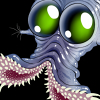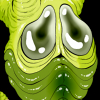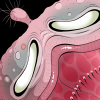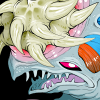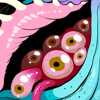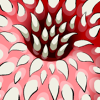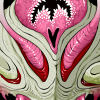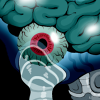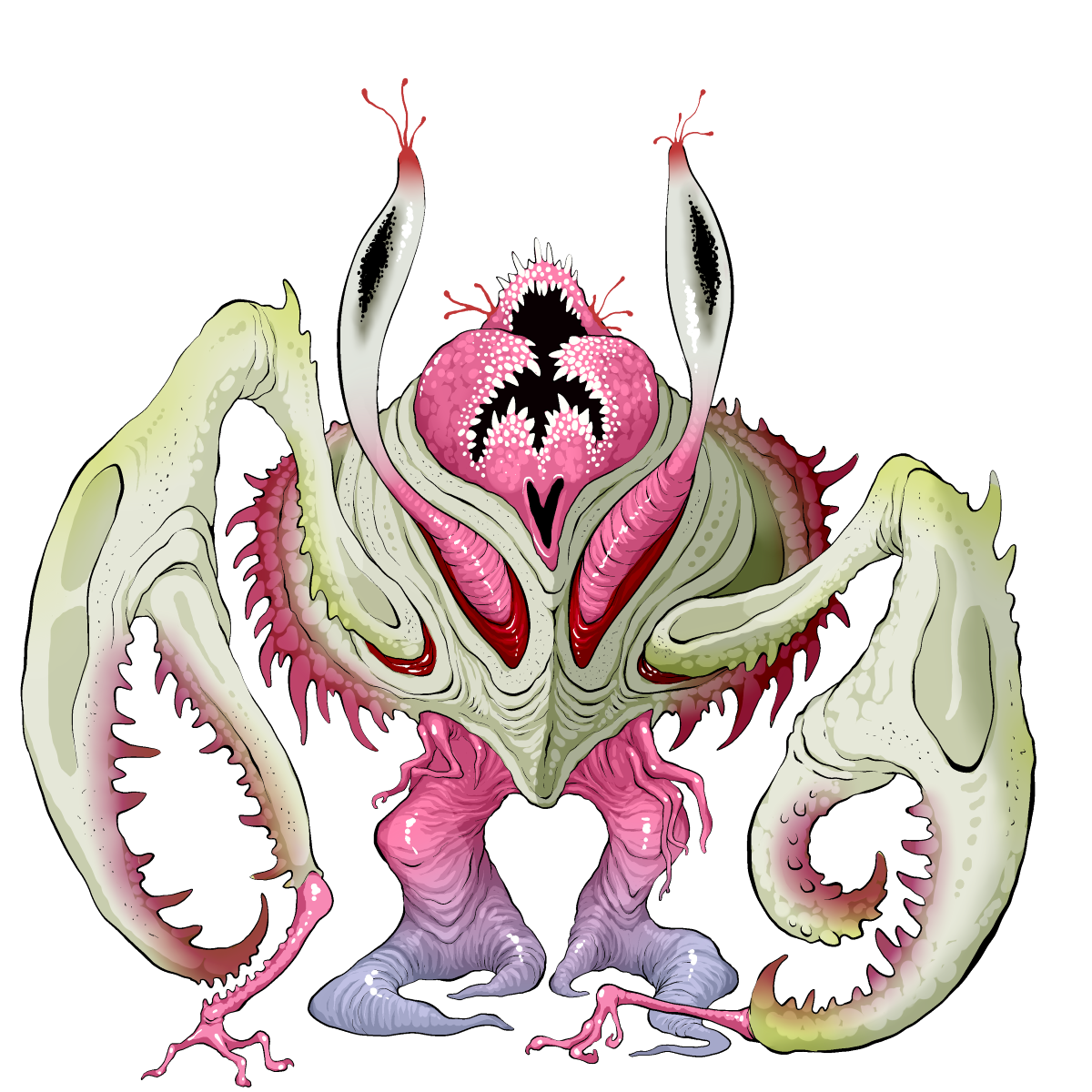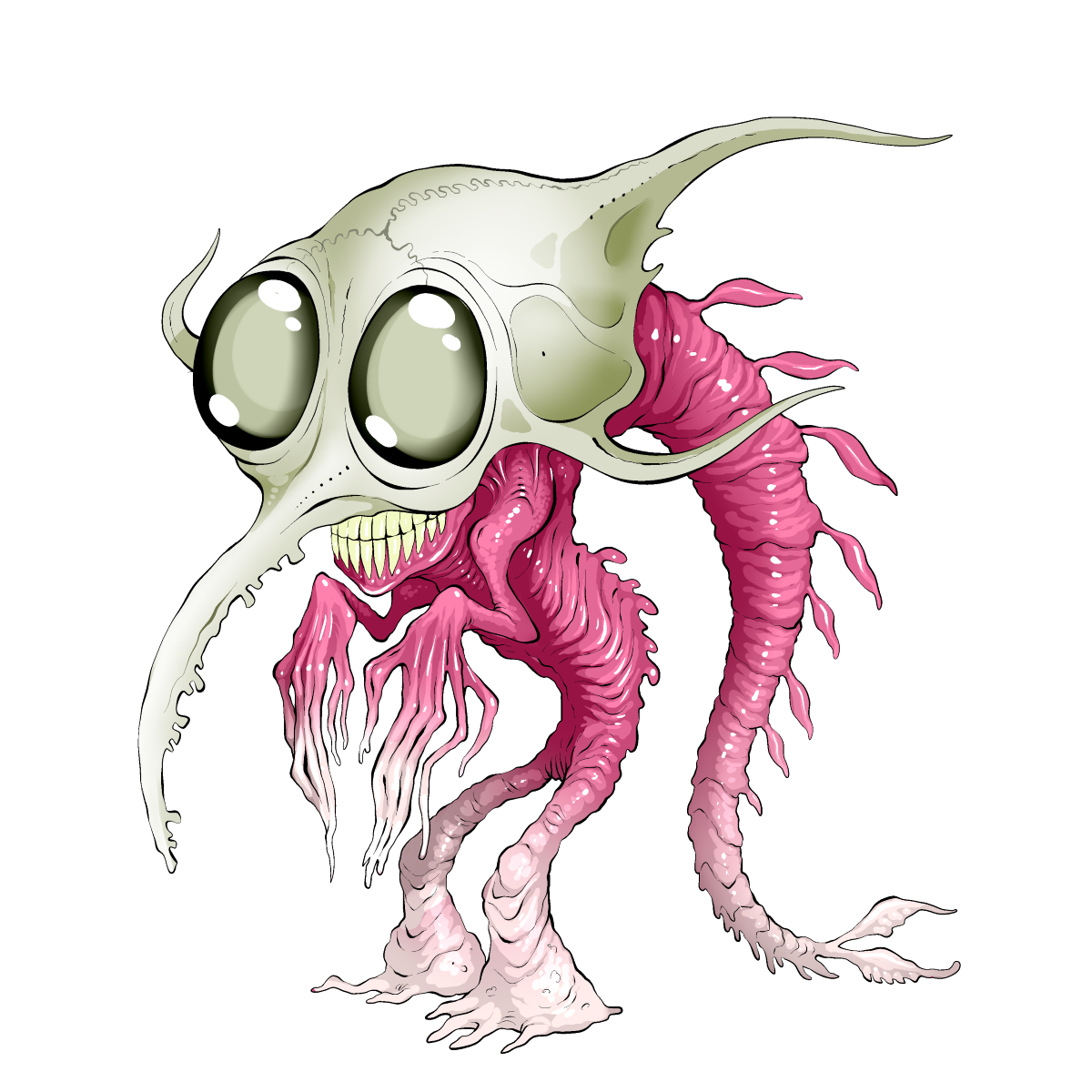BONUS MONSTER 07:
Brachyuran Corpsepicker
KRABHORRENT
CLASS: ARTHROPOID
Free, additional supplementary monsters for the Mortasheen Tabletop RPG Core RulebookCreated by Jonathan Wojcik. Stats and additional writing assistance by Bonnie Saucier
Description:
This monster resembles a large crab with two thick, wrinkled, fleshy hind legs, and six thinner, uselessly vestigial legs dangling from its "hips." Two massive crab claws and two long, tubular stalk-eyes sprout from its front, below a mouth with multiple tooth-encrusted, gummy pink jaws. A thin arm with a tiny, three-fangered hand sprouts from one tip of each claw, and the creature's body somewhat resembles an upside-down monstrous "skull."
BIOLOGY:
Biofusion of a humanoid sample with a Brachyuran crustacean. This thickly armored omnivore will attempt to eat anything it can either fit whole into its mouth or tear apart into pieces, and its claws default to constant foraging behavior every moment that the creature isn't consciously resisting this reflexive action. Meat in any state excites its hunger most, and it copiously foams at the mouth when its powerful olfactory senses catch whiff of oozing carrion or freshly spilled blood.
Comfortable in virtually any surroundings, the monster can burrow with ease, brachiate through forest canopies or power lines with its claws or paddle its buoyant body through water with its turtle-like hind legs. On land, it feels more comfortable standing upright in a bipedal posture, despite how slowly and awkwardly it locomotes in this position. A more agitated specimen moves much faster "face down," scrambling from side to side on all four limbs.
The back of a Krabhorrent's warty, rugose carapace bears a strong resemblance to a humanoid face, but the lumpy "eyes" and "lips" merely denote the underlying muscular attachment points of its limbs and eyes.
Male Krabhorrent are smaller than females, but typically develop a much larger left claw, which they wave and clatter during courtship in a complex pattern each individual strives to develop with its own creative flair. Spawning occurs in darkness, usually at a choice meeting place such as a beached animal carcass or a leaking septic line. A gravid female crab-walks continuously while brooding eggs, always ready to flee from danger, with the male typically clinging to her back as additional protection. Newborn crawlers can feed only by straining organic matter from liquid, and are reared on predigested food in a shallow pit just large enough for their mother to neatly cover with her body.
BEHAVIOR:
A mature Krabhorrent does not require an aquatic environment, but dislikes either exposure to dry air or submerging completely, preferring whenever possible to either burrow through moist substrates or remain partially immersed in a shallow body of water. It may also experience an idle urge to suck on mouthfuls of soil or sand, despite being too large to obtain meaningful nutrients from this action.
Krabhorrent find nothing more appetizing than dead or cooked crustaceans, including their own kind. Any dead or dying individual is eagerly prepared for a community feast in what all parties regard more as a casual send-off than a cannibalistic slaughter. Provided they're still conscious, the main course will typically request its preferred cooking method and provide any pointers it can offer from its personal culinary experience.
BONUS BONUS MONSTER:
Brachyuran Brine-imp
ZOAEOID
CLASS: ARTHROPOID
Description:
This monster roughly resembles a planktonic crab larva. It has a large bony skull that tapers into a long, thin, curving "nose" in front, a similar sized "horn" on the back and two additional backswept horns on its sides. The huge, tall eye sockets are filled by translucent bubble-like eyes with no pupils. A gummier, fleshier body sprouts from under the skull, with a set of humanlike teeth grinning beneath the base of the skull's snout. The body is wrinkled, pinkish and emaciated, with short arms but many long, crooked fingers, two clublike meaty legs, and a tail resembling a fleshy pink spine, which sprouts out the back of the head rather than out of the lower torso.
BIOLOGY:
Biofusion of a hominid with a crustacean in its planktonic zoea stage, producing a distinct Arthropoid species from biofusion with a mature animal specimen. This diminutive monster is passive and calm in nutrient-rich aquatic environments, content to sustain itself on protein-rich microorganisms while it drifts in the water's current. Its buoyant skull keeps it afloat effortlessly, but makes it a poor swimmer, only capable of paddling backwards with short, sluggish flexes of its tail. Its body is significantly better suited for running and jumping in terrestrial environments, but the higher metabolic cost and lack of constant plankton feed drives it to hunt more substantial protein sources, skewering smaller creatures with its rostrum or targeting select weak points as it clambers over larger quarry.
A Zoaeoid retains water in its lung-like gill sacs in order to breathe on land, and must refill its supply every six to ten hours or risk slowly asphyxiating. Its tail, derived from the spinal cord of its human component, is highly sensitive to temperature, pressure and humidity, providing it a constant subconscious awareness of distance and elevation from its watery birthplace.
Mature Zoaeoid steadily emit egg cells and gene packets while floating in water, and their tiny crawlers molt into small but completely developed Zoaeoid almost immediately upon hatching.
BEHAVIOR:
The vast majority of Zoeaoid at any given time are adrift in the ocean, idly multiplying and constantly falling prey to other creatures. With its only emotional need constantly fulfilled by microbial plankton, a filter-feeding Zoeaoid is content to go wherever the current may take it and accepts its place in the food chain.
Conversely, a "beached" Zoeaoid will all but forget its former lifesyle as the more human elements of its mind take control, surging with newfound energy, curiosity, and the urge for violence. It learns the joys of weaponry as soon as it finds an object sharper than its own spines, and may band together with others of its kind to form organized hunting parties. It may return to filter feeding if its need for water leads it back to the sea or some nutrient-rich liquid environment, but if more than one Zoeaoid colonizes the same isolated swamp or cesspit, their numbers will steadily grow until they expend all available food and flee the water as a ravenous new swarm.
Zoaeoid find Krabhorrent tastier than most other prey, but have extreme difficulty overcoming their dense natural armor without help. Krabhorrent find Zoeaoid to be appetizing snacks as well, and have no trouble at all cracking their skulls open.
Concept Notes:
Krabhorrent is an older monster, but its original design - basically an upside-down giant human head with crab appendages - doesn't really fit the modern design principles of the Arthropoid class and doesn't feel all that inspired anymore. I tried to keep the aspects of a giant upside-down face in the new design, and made it "reversible" with an additional pseudo-face on the opposite side, which you'll get to see in its pixel sprite.Zoaeoid meanwhile is the first larval crustacean Arthropoid. As mentioned before, Arthropoids can be based on different life cycle stages of natural Arthropods, but these don't metamorphose into each other; each is treated as its own separate species!
We probably should have included these both in the first book while we could, because it does detail Mortasheen city's beach, which is difficult to traverse due to the overwhelming density of its ravenous crab swarms.
GAMEPLAY BLOCKS:


WAYS YOU CAN SUPPORT THIS SITE!
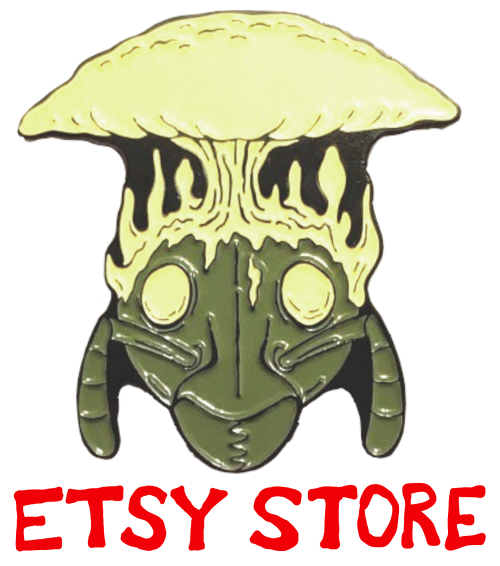
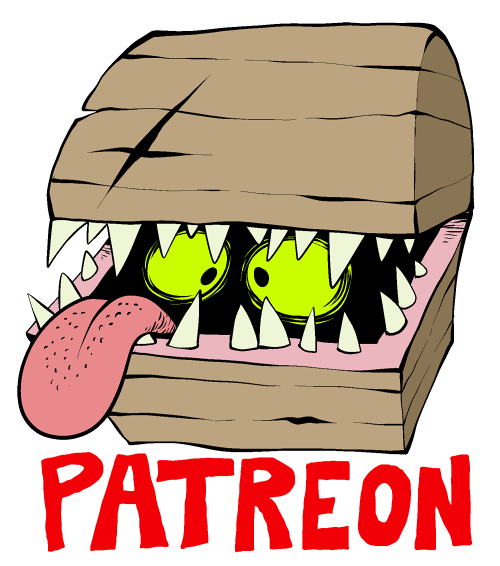
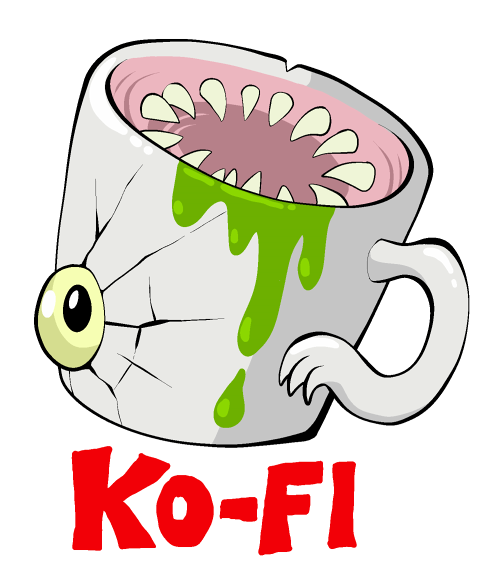
MORE:
